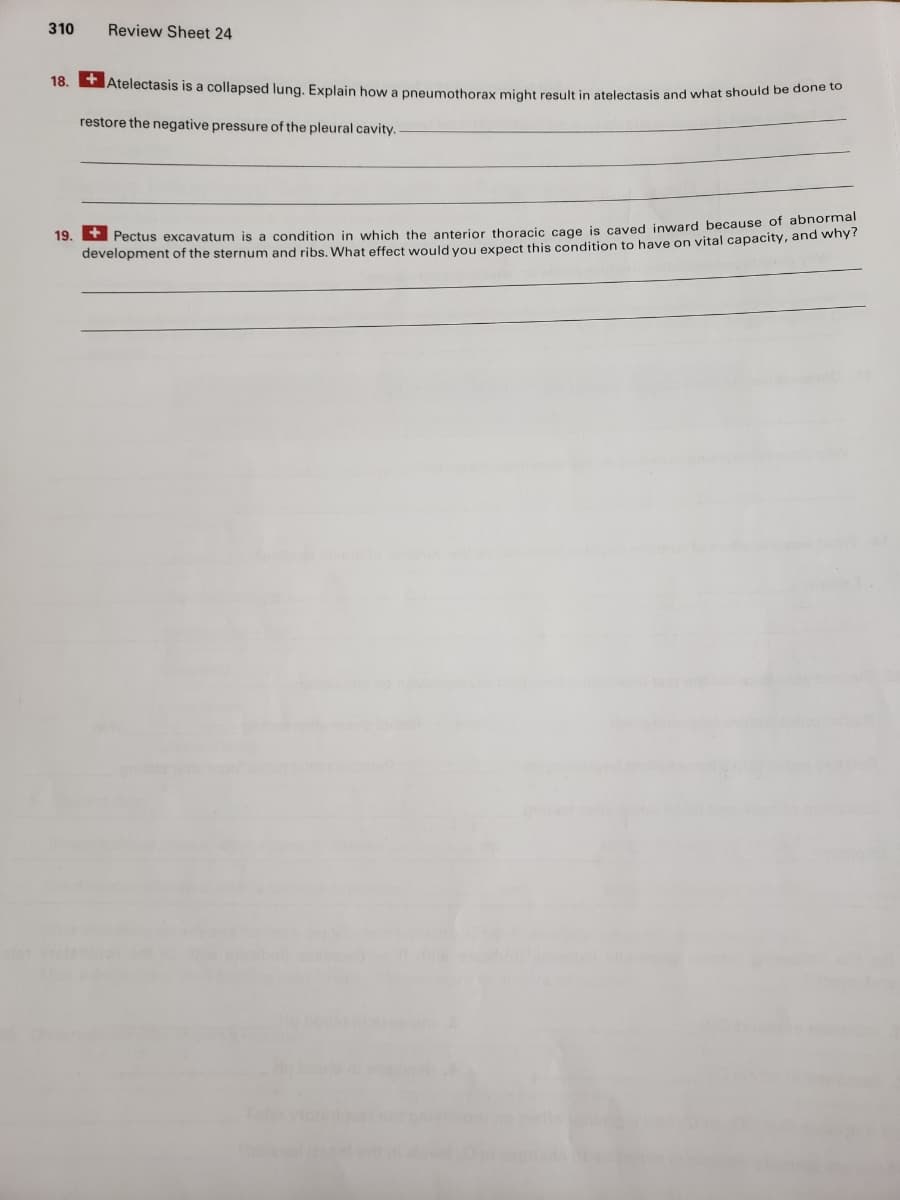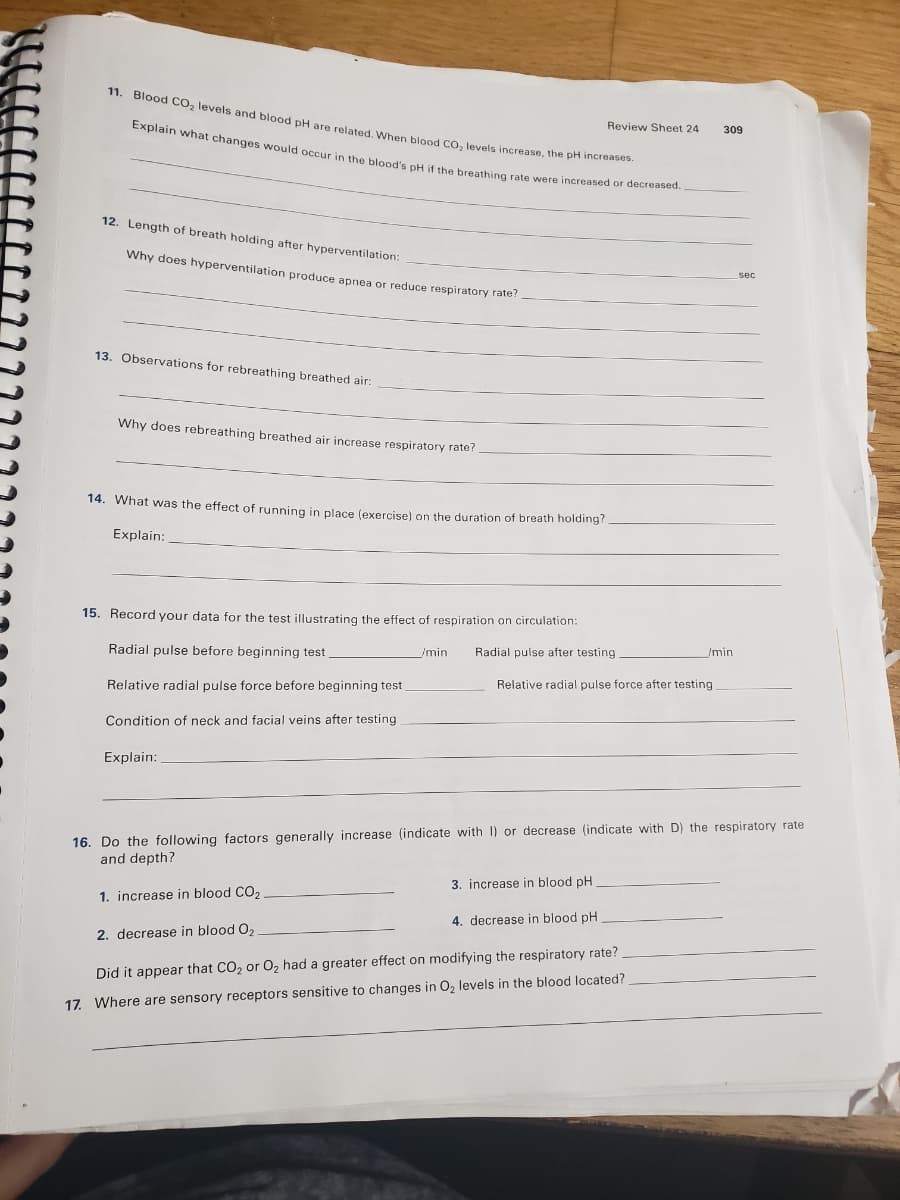Review Sheet 24 + Atelectasis is a collapsed lung. Explain how a pneumothorax might result in atelectasis and what should be done to restore the negative pressure of the pleural cavity.
Review Sheet 24 + Atelectasis is a collapsed lung. Explain how a pneumothorax might result in atelectasis and what should be done to restore the negative pressure of the pleural cavity.
Human Anatomy & Physiology (11th Edition)
11th Edition
ISBN:9780134580999
Author:Elaine N. Marieb, Katja N. Hoehn
Publisher:Elaine N. Marieb, Katja N. Hoehn
Chapter1: The Human Body: An Orientation
Section: Chapter Questions
Problem 1RQ: The correct sequence of levels forming the structural hierarchy is A. (a) organ, organ system,...
Related questions
Question

Transcribed Image Text:310 Review Sheet 24
18. + Atelectasis is a collapsed lung. Explain how a pneumothorax might result in atelectasis and what should be done to
restore the negative pressure of the pleural cavity.
19. Pectus excavatum is a condition in which the anterior thoracic cage is caved inward because of abnormal
development of the sternum and ribs. What effect would you expect this condition to have on vital capacity, and why?

Transcribed Image Text:11. Blood CO₂ levels and blood pH are related. When blood CO₂ levels increase, the pH increases.
Explain what changes would occur in the blood's pH if the breathing rate were increased or decreased.
12. Length of breath holding after hyperventilation:
Why does hyperventilation produce apnea or reduce respiratory rate?
13. Observations for rebreathing breathed air:
Why does rebreathing breathed air increase respiratory rate?
14. What was the effect of running in place (exercise) on the duration of breath holding?
Explain:
15. Record your data for the test illustrating the effect of respiration on circulation:
Radial pulse before beginning test.
Radial pulse after testing
Relative radial pulse force before beginning test.
Condition of neck and facial veins after testing
Explain:
Review Sheet 24
/min
Relative radial pulse force after testing
309
/min
3. increase in blood pH.
4. decrease in blood pH.
Did it appear that CO₂ or O₂ had a greater effect on modifying the respiratory rate?
17. Where are sensory receptors sensitive to changes in O₂ levels in the blood located?
sec
16. Do the following factors generally increase (indicate with I) or decrease (indicate with D) the respiratory rate
and depth?
1. increase in blood CO₂
2. decrease in blood O₂
Expert Solution
This question has been solved!
Explore an expertly crafted, step-by-step solution for a thorough understanding of key concepts.
This is a popular solution!
Trending now
This is a popular solution!
Step by step
Solved in 3 steps

Recommended textbooks for you

Human Anatomy & Physiology (11th Edition)
Anatomy and Physiology
ISBN:
9780134580999
Author:
Elaine N. Marieb, Katja N. Hoehn
Publisher:
PEARSON

Anatomy & Physiology
Anatomy and Physiology
ISBN:
9781259398629
Author:
McKinley, Michael P., O'loughlin, Valerie Dean, Bidle, Theresa Stouter
Publisher:
Mcgraw Hill Education,

Human Anatomy
Anatomy and Physiology
ISBN:
9780135168059
Author:
Marieb, Elaine Nicpon, Brady, Patricia, Mallatt, Jon
Publisher:
Pearson Education, Inc.,

Human Anatomy & Physiology (11th Edition)
Anatomy and Physiology
ISBN:
9780134580999
Author:
Elaine N. Marieb, Katja N. Hoehn
Publisher:
PEARSON

Anatomy & Physiology
Anatomy and Physiology
ISBN:
9781259398629
Author:
McKinley, Michael P., O'loughlin, Valerie Dean, Bidle, Theresa Stouter
Publisher:
Mcgraw Hill Education,

Human Anatomy
Anatomy and Physiology
ISBN:
9780135168059
Author:
Marieb, Elaine Nicpon, Brady, Patricia, Mallatt, Jon
Publisher:
Pearson Education, Inc.,

Anatomy & Physiology: An Integrative Approach
Anatomy and Physiology
ISBN:
9780078024283
Author:
Michael McKinley Dr., Valerie O'Loughlin, Theresa Bidle
Publisher:
McGraw-Hill Education

Human Anatomy & Physiology (Marieb, Human Anatomy…
Anatomy and Physiology
ISBN:
9780321927040
Author:
Elaine N. Marieb, Katja Hoehn
Publisher:
PEARSON